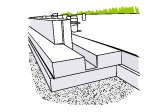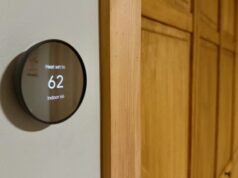
Polystyrene is an increasingly popular insulation material, used either as a part of structural insulated panels (SIPs) or as individual blocks or sheets. Polystyrene is an excellent insulator, and is relatively inexpensive.

What is it polystyrene insulation?
Polystyrene is one of the most common plastics used today – several billion kilograms are produced every year and it’s found in thousands of applications ranging from CD cases to takeaway coffee cups. Where insulation is concerned, it refers to foamed polystyrene, either as expanded polystyrene (EPS), the type found in packing foam pellets or extruded polystyrene (XPS), a more rigid-set foam which is often used for things like architectural models. Foamed polystyrene is commonly known as Styrofoam, but this is a trademarked product.
How does polystyrene insulation work?
Foamed polystyrene contains millions of tiny air bubbles trapped in the foam, many smaller than can be seen by the naked eye. Air is a poor heat conductor and since polystyrene has a high thermal resistance itself, it’s very effective at preventing heat transfer.
How effective is polystyrene insulation?
Polystyrene is a great thermal insulator, and can achieve excellent R value ratings at a given thickness for EPS, and even higher ratings for XPS. XPS polystyrene foam is more effective due to its dense structure and excellent moisture resistance. EPS will soak up moisture, and this can cause a degradation in the R value so if you are using the EPS type, it’s vital to have it protected at all times by a vapour barrier.
How much soundproofing does polystyrene insulation provide?
While polystyrene itself is a poor sound insulator, its acoustic properties change when attached to other more rigid materials, as is the case with structural insulated panels (SIPs). Under these conditions it becomes an excellent acoustic blocker.
How is polystyrene insulation supplied and installed?
Polystyrene can be used in a number of different ways as insulation; as a standalone product sold in sheets, or as a component of SIPs. When sold in sheets or panels it can be installed in much the same manner as a batt, and typically relies on friction to hold it in place, achieved by cutting a sheet slightly too big for the hole it’s going to fit in, causing it to push out on the sides a bit. It will usually be faced on one or both sides by a protective aluminium foil sheet, which helps reflect heat and provides a water barrier.
What does polystyrene insulation cost?
Polystyrene is a very low cost way to insulate your home. Installation requires very little in the way of tools or knowhow, so money can be saved on installation if you choose. As with other types of insulation, hiring a professional is always recommended to make sure it’s installed properly and effectively.
Special considerations
While this material ticks all the right boxes for thermal insulation, it does have drawbacks. It is recyclable, but it’s difficult to find anyone willing to collect it for recycling due to the vast quantities needed to make a return. As a result, much of it eventually ends up in landfills. Polystyrene has no known biological agents which can break it down, making it excellent for scientific research, but terrible for landfill. It is also flammable and can give off toxic vapours if it catches alight.





